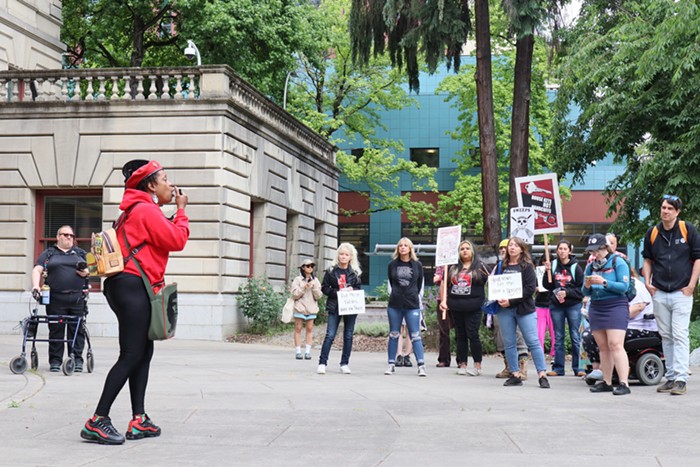All You Need:
1 gallon glass jug pasteurized
apple juice ($8)
1 packet yeast ($1)
1 airlock and stopper ($2)
HARD CIDER is the kindest of the do-it-yourself homemade alcoholic beverages. Beer must be cumbersomely boiled, wine is expensive, and poorly distilled spirits can blow up your house and fry your eyes from behind. They all take so much equipment, so many awkward conversations in dusty little shops, so much... waiting. Cider is a relative cakewalk.
I sat down with Reverend Nat West, of Reverend Nat's Hard Cider (whose facilities also host one of my culinary side projects), to help fill in the gaps of the simple process with grace notes, assurances, and troubleshooting tips. West has built a formidable business on the strength of this humble beverage, and while his approach to it is anything but simplistic, with his guidance yours can be.
On West's recommendation, we're going to make a one-gallon batch. It's less to spoil, easier to store, and cheaper to start. Most cleverly, though, pasteurized, preservative-free apple juice is already sold in one-gallon glass jugs. That strong, sterile jug is your fermentation vessel, and the juice never has to leave it until it's cider. These gallons can easily be had for less than $10; I got a couple gallons at New Seasons for $7.99 each. (Starting with fresh apples and juicing them would, for one gallon, feel like more trouble than it's worth, and the juice would still need pasteurizing.) The juice must have no preservatives: These kill yeast, and yeast is what makes cider hard.
Pour out a cup (eight ounces) of the juice to make headroom in the jug, so that the yeast doesn't clump in the neck. Traditionally, new cider-makers use unobtrusive white-wine yeasts, but West makes the point, "You're not buying great juice to begin with, so use a yeast that will give it some flavor." He recommends Belgian yeasts that give fruity notes, like saison and farmhouse. Whether you get a $1 five-gram packet of dried yeast or a $6 liquid yeast, toss it all in—don't be shy. It will do its work and no more. Just make sure the juice is between 65 degrees and 90 degrees (the packet will give specifics), or the yeast will be too cold to work or cooked to death. I used Safbrew yeasts: one gallon got all 11.5 grams of the "T-58" yeast packet, and the other got a 5-gram packet of Red Star Pasteur Champagne yeast. They both finished fermenting about the same time—around three weeks. Though West had suggested re-hydrating the yeasts in warm juice before pitching them into the jug, I didn't bother, because I believe in yeast and it thrives on my trust.
Believe it or not, the hard part of making cider is now over.
You can put a bandanna around the mouth of your jug with a rubber band, but it's worth the $2 to get a fitted stopper and one-way airlock at a brewer's supply store (they'll tell you what size stopper to get), so that you can keep ruinous bacteria out and monitor the bubbling. Soak the airlock and stopper in an iodine-based brewer's sanitizing solution like Iodophor (about $3.75 for four ounces) first, if you're thorough, then fill the airlock with water and fit the assembly firmly into the jug's neck. Save the original cap by taping it to the bottle—you'll need it again when fermentation is done. Store the jugs at room temperature, keeping in mind that colder temps mean slower fermentation.
It should be bubbling away within a couple hours (don't be distraught if it takes a day), and will carry on this way for several days. By the end of three to five weeks it should be nearly still. When you examine the meniscus in the jug closely for a minute and see absolutely zero activity—not a single pinpoint bubble rising to the surface—remove the stopper and screw the original (sanitized) lid on. You can sample your cider at this point, and it should be appreciably dry/sour and entirely drinkable, but may still have slight off flavors from the yeast. These will die off as the cider ages and the particulates settle. Let the capped cider sit for at least three weeks after the last bubble has disappeared. In two or three months it should "drop clear"—lose its haze and begin to clarify. It will be around 6.5-7.5 percent alcohol by volume (ABV).
Flavor-wise, it will only improve with age. My control batch of just juice and yeast is, at six weeks, fully dry, delicately sour, and clean—but the flavor is simplistic. The batch with an added cup of homemade rose hip syrup (1:1 ratio of water to sugar) is leagues ahead in complexity and enjoyability. I wouldn't dare say it's Reverend Nat quality, but I wouldn't feel like a dupe if I paid money for it.
Finessing Your Cider
You wouldn't be a true home brewer if you didn't futz with the flavors of this basic recipe. For liquid ingredients, West suggests squeezing in the contents of a honey bear, whole berries (blueberry, blackberry, raspberry), or maple syrup. A small amount of whole toasted spices will also work: a stick of cinnamon, a few dried cloves, a crushed whole nutmeg. Spices should be added only during the last two weeks of your intended storage period, as they can easily overpower the flavor of the fruit. Hops are also fair game, to the tune of about 15 pellets a gallon. (Pellets are preferred to whole leaf in this method, as they'll fall to the bottom.) In one batch, I swapped out an extra cup of juice and replaced it with a simple syrup flavored with rose hips.
Want to start your cider fermenting with a more historically accurate method? Forego the yeast and drop in a half-bunch of red grapes, which pack their own surface yeast. A handful of raisins will start the fermentation as well, and add depth to the flavor.
If you'd like to create a sparkling cider, add a teaspoon of cane sugar to each 22-ounce bottle at bottling time. Swing-top bottles are recommended, so pressure can be checked. (Or do like I do, and have one of your bottles be a plastic one, so you can squeeze it as pressure builds and therefore infer how the glass ones are doing.)
Troubleshooting
If a film of yeast develops on the surface of your fermenting product, don't fret. It just means the juice came into contact with air. Skim it off, or siphon through it when it's time to rack the cider. It won't affect the flavor as long as it doesn't sink to the bottom.
If mold grows on top of the juice, fermentation is not happening, possibly because the juice has been too cold, or exposed to air. Skim off the mold and pitch in new yeast.
If fermentation doesn't happen in a day or two, the yeast didn't establish, likely because the juice was too cold or too hot. Get the temperature within the recommended window and pitch in a new batch of yeast.
Further Reading
To learn everything possible about cider making—from the soil up—please consult cider.org.uk, a masterful and exhaustive resource.



















